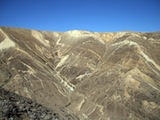Édouard Ravier PhD thesis
 Soft-sediment deformation structures induced by fluid overpressure in subglacial and deep-marine environments: palaeoenvironmental and reservoir implications
Soft-sediment deformation structures induced by fluid overpressure in subglacial and deep-marine environments: palaeoenvironmental and reservoir implications
Defended on the 11th December 2014
Funding: ministry of research + GDF Suez
Supervisors: Michel Guiraud and Jean-François Buoncristiani
Started in October 2011
Abstract
Soft-sediment deformation structures (SSDs) occur in unconsolidated sediments, during or shortly after deposition. SSDs are abundant in subglacial and deep-marine environments because of the development of fluid overpressure. Case studies of these two sedimentary environments were used (1) to reconstruct palaeoenvironments from SSDS, and (2) to define the impacts of SSDS on glacial morphologies and (3) petrophysical properties.
(1) Analyses of strain regimes, deformation mechanisms, and chronologies in SSDs served to improve palaeoenvironmental reconstructions. These structures were used as proxys to estimate variations of ice flow velocities, ice thickness, meltwater production, and position of the ice margin.
(2) The sedimentary series of Ordovician tunnel valleys record numerous SSDs induced by fluid overpressure. A new model of tunnel valley formation controlled by the increase of porewater pressure in the bed is proposed. This model of formation occurs in inter-ice stream zones, where meltwater is transferred to the substratum. In ice-stream corridors, meltwater circulates at the ice-bed interface and promotes the formation of tunnel valleys controlled by meltwater processes.
(3) Remobilisation processes triggered by the increase of fluid pressure have an impact on the granular framework and on the geometry of reservoirs. Petrophysical studies of subglacial and deep-marine sandstones demonstrated the impact of fluid overpressure on reservoir properties. Processes of fluidisation are responsible for the increase in porosity/permeability, while elutriation processes lead to a decrease in these petrophysical properties.
Keywords
Soft-sediment deformation structures, fluid pressure, subglacial environment, deep-water environment, palaeoenvironmental reconstructions, reservoir properties, tunnel valleys
- extrait:
- lien_externe:
- kc_data:
- a:8:{i:0;s:0:"";s:4:"mode";s:0:"";s:3:"css";s:0:"";s:9:"max_width";s:0:"";s:7:"classes";s:0:"";s:9:"thumbnail";s:0:"";s:9:"collapsed";s:0:"";s:9:"optimized";s:0:"";}
- kc_raw_content:
 Soft-sediment deformation structures induced by fluid overpressure in subglacial and deep-marine environments: palaeoenvironmental and reservoir implications
Soft-sediment deformation structures induced by fluid overpressure in subglacial and deep-marine environments: palaeoenvironmental and reservoir implicationsDefended on the 11th December 2014
Funding: ministry of research + GDF Suez
Supervisors: Michel Guiraud and Jean-François Buoncristiani
Started in October 2011
Abstract
Soft-sediment deformation structures (SSDs) occur in unconsolidated sediments, during or shortly after deposition. SSDs are abundant in subglacial and deep-marine environments because of the development of fluid overpressure. Case studies of these two sedimentary environments were used (1) to reconstruct palaeoenvironments from SSDS, and (2) to define the impacts of SSDS on glacial morphologies and (3) petrophysical properties.
(1) Analyses of strain regimes, deformation mechanisms, and chronologies in SSDs served to improve palaeoenvironmental reconstructions. These structures were used as proxys to estimate variations of ice flow velocities, ice thickness, meltwater production, and position of the ice margin.
(2) The sedimentary series of Ordovician tunnel valleys record numerous SSDs induced by fluid overpressure. A new model of tunnel valley formation controlled by the increase of porewater pressure in the bed is proposed. This model of formation occurs in inter-ice stream zones, where meltwater is transferred to the substratum. In ice-stream corridors, meltwater circulates at the ice-bed interface and promotes the formation of tunnel valleys controlled by meltwater processes.
(3) Remobilisation processes triggered by the increase of fluid pressure have an impact on the granular framework and on the geometry of reservoirs. Petrophysical studies of subglacial and deep-marine sandstones demonstrated the impact of fluid overpressure on reservoir properties. Processes of fluidisation are responsible for the increase in porosity/permeability, while elutriation processes lead to a decrease in these petrophysical properties.
KeywordsSoft-sediment deformation structures, fluid pressure, subglacial environment, deep-water environment, palaeoenvironmental reconstructions, reservoir properties, tunnel valleys
